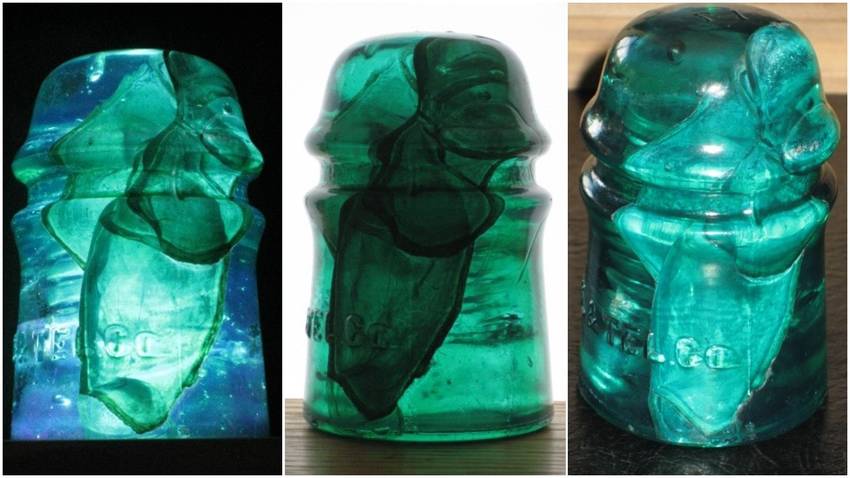Christmas Treat #4: Nature's Artwork -- It's so bad, it's good
By Colin Jung; posted December 17, 2018
View Original: Click to zoom, then click to magnify (1280 x 720) 230KB

|
Aqua AM. TEL. & TEL. CO. toll, CD 121. Left side is photographed base-lit; center is photographed back-lit and right side is photographed with the flash on. I think what happened here is the insulator spent some time on the ground and had a couple of good-size bubbles or milky impurities that generated cracks due to extreme temperature variations. The cracks migrated to the outside surface of the insulator, which allowed rain/moisture to seep into the insulator. Expansion and contraction of the water during freeze/thaw cycles widen the cracks, allowing more rain/moisture to seep inside. When this happens you usually see only one fracture plane in an affected insulator. This seemed to happen in several places in this insulator. The rain/moisture had dissolved minerals that crystallized inside the insulator (the white color stuff in photo 3) . Larger black particles didn't migrate into the cracks as much and are concentrated along the crack lines. There is no damage in the interior of the pinhole nor is there any evidence of damage on the outside of the insulator aside from the hairline cracks. Paul Greaves responded to the photo and caption with the following on 12/18/18: Thought I'd make a comment on this... I have seen and studied a lot of insulators with this sort of fracturing. I have even dug a number out of the ground, and also tried to repair some by separating the glass along the fracture lines and cleaning the white stuff off, and gluing them back together. (Usually this results in a less than perfect result, but can help.) This effect is not caused by preexisting milk or impurities in the glass. It usually is caused by some sort of stress or damage leading to a crack (can be very small) that leads to further deterioration of the glass and further cracking. Internal stresses may contribute. In any case, the white stuff is glass deterioration, also called glass sickness or crizzling. Look it up on Google if you are curious... there are a lot of interesting articles on it! In fact, there is a whole science devoted to understanding it and controlling it for historic glass in museum displays. The white stuff is decomposed glass. When separated and examined, it can be scraped off as a powder or crumbly substance. During the deterioration process, it can separate the glass so dirt can get in the edges of the crack. It's a complicated subject, too much for an ICON post... but glass formula has a huge effect on it. Some glass is very prone to it, others not much at all. Brookfield and Elmer, NJ glass seems to be especially prone to it. EC&M glass (for example) rarely shows this kind of white cracking. Burial and some kinds of weathering environments can make it especially prone to happening. Soil minerals or contaminants can also have a big effect. In my experience, complete immersion in water or constantly damp dirt can protect the glass. Repeated wetting and drying makes it worse, but rapid drying after wetting makes it less likely. This is why glass found in the desert can be shiny where it is exposed (rapid drying) but sick where it is buried. I think it also explains why the white stuff is inside the cracks, but the surface is relatively OK sometimes. In other cases insulators found along a line have been seen badly sick, but where the line went across a swamp, insulators pulled from the swamp were fine. An interesting and complicated subject! |